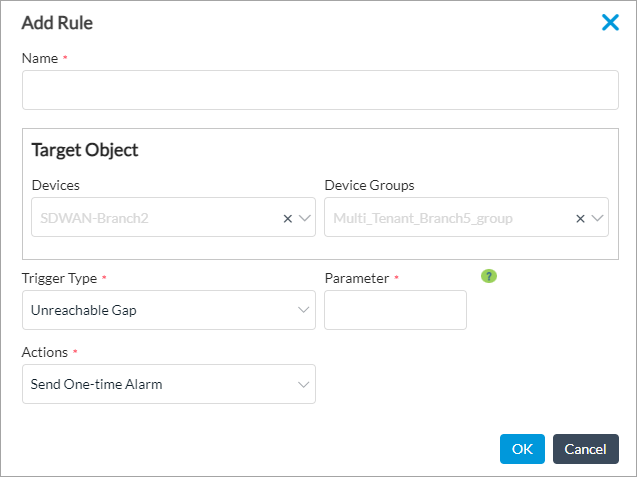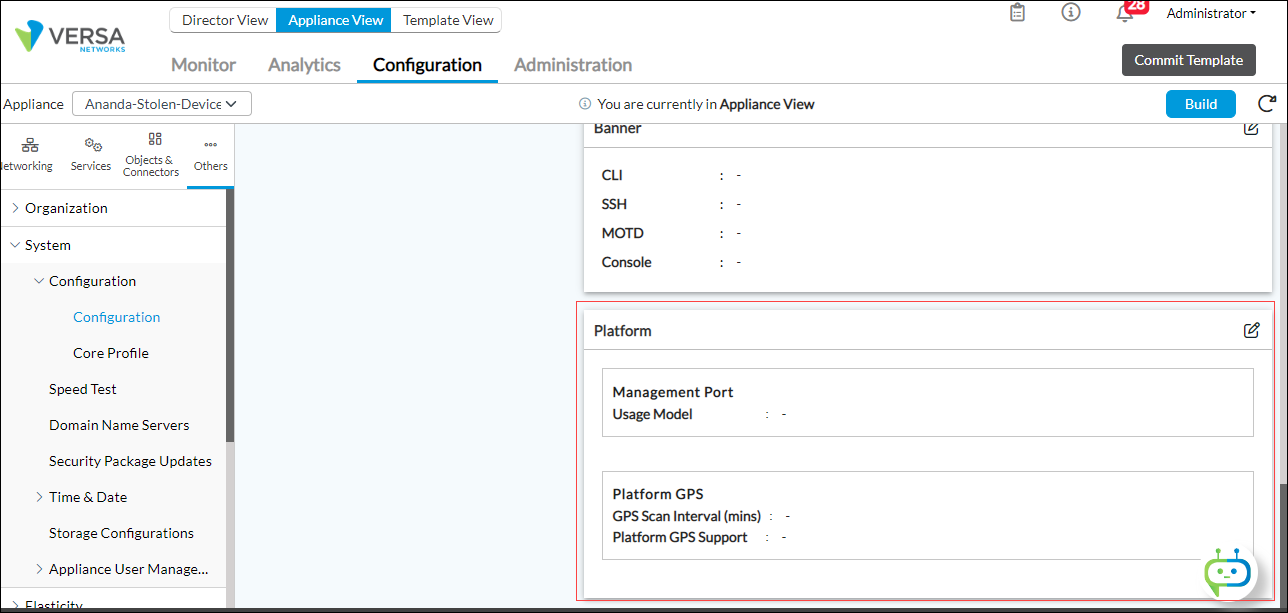Configure Device Location Tracking
![]() For supported software information, click here.
For supported software information, click here.
For all Versa Operating SystemTM (VOSTM) devices, you can configure tracking of its location so that if it is moved or tampered with without authorization, notifications are sent to alert you. You can also configure actions to take when the unauthorized movement of a device is reported.
In addition, for CSG700 Series appliances, you can separately configure the Director node to track the GPS location of the device. With this configuration, the location of the CSG700 device is displayed on the Director Monitor screen, but no notifications are sent and no actions are taken.
Configure Unauthorized Movement Detection
For all VOS devices, including CSG700 Series appliances, you can configure detection of unauthorized device movement. Such unauthorized movement may indicate that a device has been compromised because it has been stolen or moved without authorization. When unauthorized movement occurs, the VOS devices send notifications and can take actions based on the detected condition.
When a VOS device boots and establishes a connection with the Director node, the Director node collects information about the device, including its WAN and other interfaces and their IP addresses, its GPS location, and, for WWAN devices, the coordinates of its cell tower. Thereafter, the Director node periodically checks the VOS device's reachability and collects the device's interface addresses and location.
When configuring unauthorized movement detection, you can track the following conditions whose occurrence may indicate that a VOS device may have been compromised:
- Change in reachability—The VOS device has not been reachable from the Director node for a period of time, or the device has been turned on again after having been unreachable for a period of time.
- Change in public IP address—The device's IP address has changed or a WAN interface has been added to a device.
- Change in GPS location—The device's GPS location changes.
- Change in cell tower coordinates—The device's physical cell tower location changes.
- Change in LTE cell ID—The device's LTE cell ID changes.
You can configure the following actions to take when one of the conditions above is reported:
- Mark the device status in the device inventory list as being Stolen Suspected.
- Update the VOS device status record in 5 minutes to report the Stolen Suspected" status. To view the updated status, you must refresh the Director GUI screen.
- Log the notification.
VOS devices whose security have been compromised because they have been moved without authorization or accessed by an unauthorized party are referred to in the VOS software as stolen devices. When a Director node determines that a device has been moved without authorization, it marks the device with the status Stolen Suspected.
Configure Rules for Detecting Unauthorized Device Movement
To track conditions whose occurrence may indicate that a VOS device may have been compromised, and to define the action to take when such a condition occurs, you configure a rule. You can configure rules for individual devices and for device groups.
To configure rules for detecting unauthorized device movement:
- In Director view, select the Administration tab in the top menu bar.
- Select Inventory > Stolen Devices > Rules in the left menu bar.

- Click the
Add icon. In the Add Rule popup window, enter information for the following fields.

Field Description Name (Required) Enter a name for the rule. Target Object (Group of Fields) - Devices
Select one or more devices to which to apply the rule. You must select at least one device or device group. - Device Groups
Select one or more device groups to which to apply the rule.You must select at least one device or device group. Trigger Type (Required)
Parameter (Required)Select the condition whose occurrence triggers the sending of a notification, and then enter a value for the trigger type:
- Change in cell ID—Send a notification when the device moves to one of the specified LTE cell IDs. Enter the cell IDs as a comma-separated list.
- Change in GPS—Send a notification when the device has moved the specified distance or farther from its previously known location. Enter the distance as an integer. The distance is either in miles or kilometers, depending on the distance units configured on the D
- Change in Public IP address—Send a notification when the device's public IP address has change. Enter the address as a mask of the significant (left-most) bits, for example, 255.255.252.0. If the address changes so that it is outside of this mask, a notification is sent.
To illustrate how the IP address change is determined, supposed that the the IP address mask is 255.255.255.0 and that the previous two IP addresses are 10.4.5.6 and 10.34.23.4. If the two new IP addresses are 10.4.5.77 and 10.34.23.66, there is no trigger, because the difference is within the provided mask. However, if the two new IP addresses are 10.4.5.8 and 10.34.24.88, the match is triggered, because the difference for the second IP address is too large. - Reachable Again Gap—Send a notification when the device that was not reachable from the Director node is reachable again after the specified amount of time. Enter the time in minutes.
- Unreachable Gap—Send a notification when the device is not reachable from the Director node for the specified amount of time. Enter the time in minutes.
Action (Required) Select the action to take when a trigger condition occurs:
- Send a One-Time Alarm—Send a single alarm to the Director node, which you can display by clicking the Notification Bell icon in the top menu bar in the Director GUI.
- Send Continuous Alarm—Send alarms continuously to the Director node. You can display the alarms by clicking the Notification Bell icon in the top menu bar in the Director GUI.
- Disable Device and Send Continuous Alarm
- Click OK.
View Logs for Unauthorized Device Movement
To view the logs for devices that have been moved without authorization:
- In Director view, select the Administration tab in the top menu bar.
- Select Inventory > Stolen Devices > Logs in the left menu bar. The following screen displays.

Take Actions for Devices Suspected of Being Stolen
When a Director node determines that a device has been moved without authorization, it marks the device with the status Stolen Suspected. You can view these devices and can take the following actions:
- Turn on the device.
- Turn off the device.
- Enable the device.
- Disable the device.
To take an action for a device that is suspected of being stolen:
- In Director view, select the Administration tab in the top menu bar.
- Select Appliances in the left menu bar.
- Select the device name in the main panel.

- Select the action to perform on the suspected stolen devices:
- Click the
icon to turn on the device.
- Click the
icon to turn off the device.
- Click the
icon to enable the device.
- Click the
icon to disable the device.
- Click the
Configure Device Tracking for CSG700 Devices
For CSG700 series appliances, you can configure the Director node to track the GPS location of the device. The Director node then performs a search to locate the CSG700 series appliances and makes a note of its location. When the device's location changes, the Director node receives a notification that contains the new GPS coordinates. When a device reboots, the Director node deletes the existing location information and starts a new search to locate the CSG700 series appliance.
Configuring device tracking can help identify whether a device has been moved or stolen, and it can help to find the device.
To have the Director node track the GPS location of a CSG700 series appliance, you must connect an external GPS antenna to the device. For more information, see CSG700 Series Appliances Front and Rear Panel Components.
Configure GPS Location Tracking
To configure the Director node to track the GPS location of a CSG700 series appliance:
- In Director view:
- Select the Administration tab in the top menu bar.
- Select Appliances in the left menu bar.
- Select a device name in the main panel. The view changes to Appliance view.
- Select the Configuration tab in the top menu bar.
- Select Others > System > Configuration > Configuration in the left menu bar. The following screen displays.

- In the Platform pane, click the
 Edit icon. In the Edit Platform popup window, select the Platform GPS tab, and enter information for the following fields.
Edit icon. In the Edit Platform popup window, select the Platform GPS tab, and enter information for the following fields.

Field Description Platform GPS Support Click to enable support for tracking the GPS location of a CSG700 series appliance.
Default: Disabled
GPS Scan Interval Enter how often the Director node scans for the GPS location of the device, in minutes. If the device is not located within the configured time interval, the search stops until the next interval begins.
Range: 30 through 10800 minutes (7 days)
Default: None - Click OK.
Monitor GPS Location Information
To monitor GPS location information on a CSG700 device:
- In Director view:
- Select the Configuration tab in the top menu bar.
- Select Devices > Devices in the horizontal menu bar.
- Select a device in the main pane. The view changes to Appliance view.
- Select the Monitor tab in the top menu bar.
- In the Organization field, select the provider organization and then select the System tab. The device summary section displays a map showing the device's location, address, and location coordinates.

To display the GPS location for a CSG700 series appliance, issue the show system gps location platform command. For example:
admin@versa-vos-cli> show system gps location platform Latitude: 37.4148 N Longitude: 121.9733 W Date: 2022-05-13 22:54:29 (GPS) Altitude: 15.9 m
To display the cellular or WWAN GPS location information for any device, issue the show system gps location cellular command. For example:
admin@versa-vos-cli> show system gps location cellular Latitude: 37.695141667 N Longitude: 121.78761944 W Date: 2022 01 25 1 04:27:15 (GPS) Altitude: 124 m
To start or restart the GPS platform location search, issue the following command:
admin@versa-vos-cli> request system gps platform location-search start
admin@versa-vos-cli> request system gps platform location-search start GPS location search is already in progress
To stop the GPS platform location search, issue the following command:
admin@versa-vos-cli> request system gps platform location-search stop [ok][2022-05-23 16:40:16]
To display status of GPS platform search operation, issue the following command:
admin@versa-vos-cli> request system gps platform location-search status GPS location search is running
admin@versa-vos-cli> request system gps platform location-search status GPS location search is not running
The GPS location information logs are stored in the /var/log/versa/versa-csg-gps.log file.
Supported Software Information
Releases 22.1.1 and later support all content described in this article.
